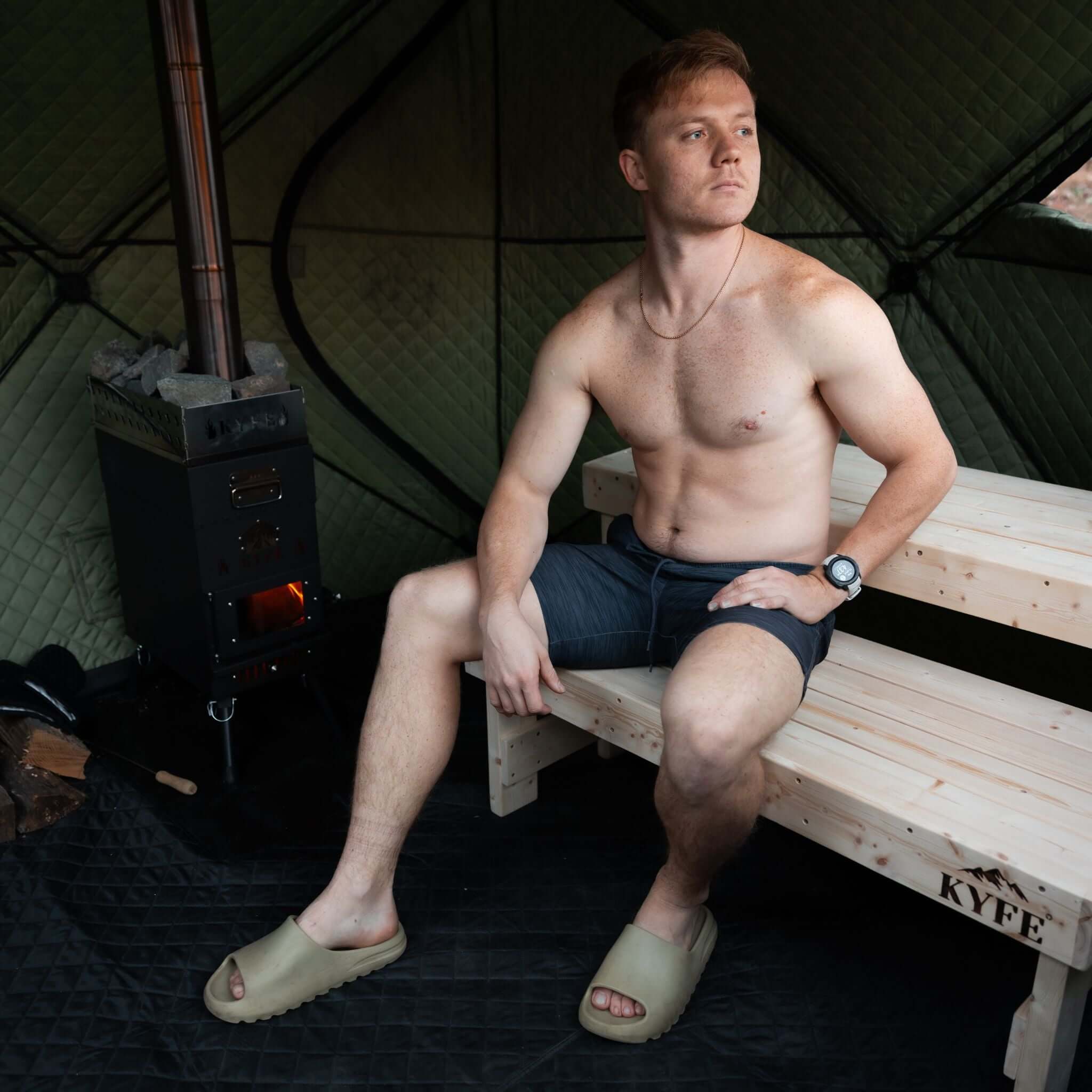The rise of portable saunas has transformed the way we experience wellness. What was once confined to spas and permanent saunas can now be enjoyed in backyards, cabins, campsites, and even rooftops. From compact sauna tents to high-performance wood-burning setups, today’s options are as diverse as the people who use them.
But as these space-saving, steam-powered sanctuaries gain popularity, a vital question emerges: are portable saunas safe?
When used properly, the answer is yes. Portable saunas offer a safe and effective way to enjoy the health benefits of traditional heat therapy. But safety depends on a few key factors: setup, usage, and understanding how different models generate heat. Whether you're a first-timer or a seasoned sauna enthusiast, this guide walks you through everything you need to know—so your next sweat session is as safe as it is soul-soothing.
Understanding Portable Saunas: What They Are and How They Work

How Portable Saunas Work
At their core, portable saunas are designed to create steam or emit infrared heat to raise your body temperature and activate promoting sweating. They mimic the essential effects of traditional saunas—but with added flexibility and mobility.
Depending on the model, they can use fire, electricity, or infrared heat to generate heat. High-end units like the Kyfe Sauna utilize dry saunas with wood-burning stoves and sauna rocks to produce real wet heat and high heat—over 200°F—far beyond the capacity of smaller tent saunas or sauna blankets.
Types of Portable Saunas
The term “portable sauna” encompasses a wide range of products. Here’s a breakdown:
-
Wood-burning tent saunas: Like Kyfe, these replicate conventional saunas with real fire and stones. They’re ideal for outdoor settings and communal use.
-
Portable steam saunas: These plug-in tents use electric steamers to create wet heat and are usually used solo.
-
Infrared saunas: Often found as sauna blankets or compact cabins, these use light to warm the body from within, offering gentle heat at lower temperatures.
-
Sauna tents and tent saunas: These are often more spacious, full-height structures designed for true sauna sessions in nature.
Why They’re Gaining Traction
Modern users crave wellness experiences that fit their lifestyle. Whether you're an entrepreneur with limited downtime or a traveler seeking recovery on the go, portable saunas provide unmatched convenience. They are:
-
Space saving and easy to store
-
Less expensive than building a regular sauna
-
Fast to set up with zero construction
-
Versatile enough to use in a variety of outdoor environments
And when it comes to performance, some portable sauna tents rival even the best conventional saunas—offering heat, steam, and deep muscle relaxation wherever you need it.
Are Portable Saunas Safe to Use?

General Safety Guidelines
Used correctly, portable saunas are generally very safe. But misuse can lead to dehydration, burns, or worse. Here are a few non-negotiables:
-
Limit each sweat session to 15–20 minutes
-
Stay hydrated by drinking water before and after
-
Monitor your body’s response—dizziness or nausea means it's time to step out
-
Never use a sauna while drinking alcohol, which impairs heat regulation
-
Always place the unit on a flat, fire-safe surface (especially if using a wood stove)
-
Use provided accessories like temperature controls, gloves, and fire-safe gear when available
Recognizing Risks
All forms of sauna bathing carry some level of risk if used improperly. Potential hazards include:
-
Dehydration from excessive sweating without proper hydration
-
Overheating and heat stroke from sessions that are too long
-
Skin burns from touching hot surfaces or steam vents
-
Respiratory irritation from poor ventilation or harmful chemicals (especially in cheap units)
Reputable brands like Kyfe are built to mitigate these risks with engineered airflow, heat-resistant materials, and comprehensive user instructions.
Traditional Sauna vs. Infrared and Steam Saunas: What’s the Difference?

Comparing Heat Types
Let’s break down the three primary heat sources:
-
Dry sauna (like Kyfe): Heats air and rocks to create wet heat when water is poured over. Offers high temps and the most intense experience.
-
Infrared sauna: Uses light waves to warm your body directly. Ideal for gentle heat and lower blood pressure stimulation.
-
Portable steam saunas: Plug-in units that boil water to create steam sauna conditions. Often used indoors in short bursts.
Each has unique benefits—but also varying safety aspects. Infrared is milder, but lacks the communal intensity. Steam saunas hydrate the skin but can feel stifling in small spaces. A traditional sauna gives you full-spectrum sauna benefits with intense heat distribution, real stones, and the ability to create steam at will.
What Are the Health Benefits of Sauna Use?

Why Sauna Bathing Has Stood the Test of Time
People across cultures have used saunas for centuries. Modern science supports the tradition. Consistent use of sauna tents, dry saunas, and steam saunas is linked to several major health advantages:
-
Enhanced cardiovascular health
-
Reduced inflammation and pain relief
-
Improved blood circulation
-
Relief from tight muscles and joint stiffness
-
Detoxification through sweat
-
Deep stress relief and better sleep quality
Whether you’re using a tent sauna or a hot tub, the goal is the same: create controlled stress that helps your body reset, recover, and rejuvenate.
Portable Sauna Setup and Safety: What You Need to Know
Safe Setup Tips
Using a sauna tent or tent sauna safely starts with proper setup:
-
Choose a flat, ventilated area with 2+ feet clearance on all sides
-
Avoid low-hanging trees or brush
-
Anchor your tent securely using the included ropes or weights
-
Install chimneys or vents correctly to manage smoke and heat distribution
Cleanliness and Maintenance
Like any wellness tool, your sauna should be cleaned and dried after each use:
-
Wipe down interior with a microfiber towel
-
Remove ashes and dry completely to prevent mold
-
Store your portable sauna in a cool, dry space during bad weather
-
Always maintain hygiene—especially in shared saunas
Essential Oils, Accessories, and What to Avoid
Can You Use Essential Oils in Portable Saunas?
Yes—but use with caution. Essential oils can enhance your relaxing experience, but never drop them directly on hot rocks. Instead:
-
Mix oils with water before pouring on rocks to create steam
-
Use only sauna-safe oils like eucalyptus, peppermint, or lavender
-
Never use synthetic fragrances or oils with flammable ingredients
Accessories That Elevate the Experience
-
Remote control temperature units for plug-in steam tents
-
Cedar benches for better airflow in sauna tents
-
Microfiber towel wraps to prevent skin irritation
-
Fireproof gloves and pokers (included with Kyfe) for safety
Who Should Avoid Saunas or Consult a Doctor?
Know Before You Sweat
Certain groups should check with a sauna expert or physician before starting a routine:
-
People with heart disease or unstable blood pressure
-
Pregnant individuals
-
Those with respiratory or neurological conditions
-
Anyone taking medications that affect sweating or temperature control
-
Children under 18
If you’re ever unsure, it's best to start slow and consult your healthcare provider first.
Sauna Safety FAQs
Are portable saunas safe for indoor use?
Most sauna tents and wood-burning saunas are for outdoor use only. Infrared and portable steam saunas may be used indoors but require proper ventilation and heat-proof surfaces.
What’s safer: infrared or dry sauna?
Both are safe when used properly. Infrared offers gentle heat at lower temperatures, while dry saunas deliver high heat and a more intense experience.
Can I use a sauna blanket instead?
Sauna blankets are compact and convenient but lack airflow and heat distribution. They're best for short sessions and solo use—not a replacement for full-body, traditional sauna bathing.
How long should I stay in?
15–20 minutes per round, with cool-down periods. And always drink plenty of water before, during, and after your sweat session.
The Kyfe Sauna Standard: Built for Performance, Safety, and Experience
With Kyfe, you don’t just buy a portable sauna—you invest in an immersive, elevated wellness ritual. Every detail of our tent sauna is engineered for safety aspects, performance, and ease of use. From pre-seasoned furnace systems to airflow-regulating vents and clear instruction manuals, we ensure your experience is as safe as it is restorative.
Kyfe clients don’t compromise. They seek function, form, and the soul-stirring clarity only found in fire, stone, and steam.
Final Thoughts: Yes, Portable Saunas Are Safe—When You Choose the Right One
Portable saunas are more than a trend—they’re a lifestyle upgrade. But safety is non-negotiable. Whether you’re using a portable steam sauna, dry sauna, or traditional wood-fired tent, thoughtful use and proper setup make all the difference.
When you choose Kyfe, you’re not just stepping into heat. You’re stepping into a relaxing experience, a time-tested tradition, and a commitment to your own wellbeing.
Ready to Heat Things Up, Safely?
Explore the Kyfe Sauna collection or connect with a lifestyle manager to find the setup that fits your schedule, space, and sense of balance. This isn’t just a sauna. It’s your sanctuary.



Do Portable Saunas Work? A Complete Guide to What You Can Expect
How to Clean a Portable Sauna: A Complete Care Guide for Wood-Burning Models